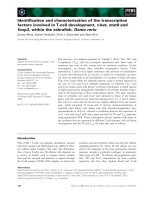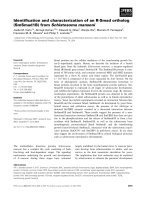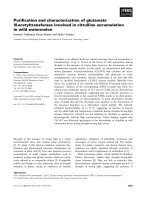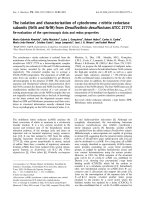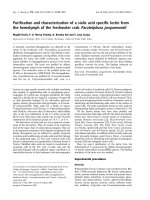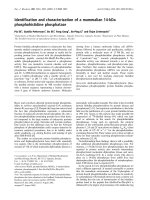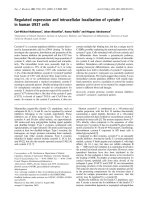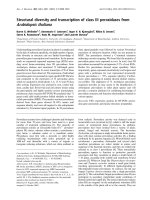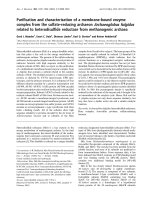Báo cáo y học: "Cloning, expression and characterization of gE protein of Duck plague virus" doc
Bạn đang xem bản rút gọn của tài liệu. Xem và tải ngay bản đầy đủ của tài liệu tại đây (921.05 KB, 11 trang )
Chang et al. Virology Journal 2010, 7:120
/>Open Access
RESEARCH
© 2010 Chang et al; licensee BioMed Central Ltd. This is an Open Access article distributed under the terms of the Creative Commons
Attribution License ( which permits unrestricted use, distribution, and reproduction in
any medium, provided the original work is properly cited.
Research
Cloning, expression and characterization of gE
protein of Duck plague virus
Hua Chang
†1
, Anchun Cheng*
†1,2,3
, Mingshu Wang
†1,2
, Dekang Zhu
†1,2
, Renyong Jia
†2
, Fei Liu
2
, Zhengli Chen
2
,
Qihui Luo
2
, Xiaoyue Chen
1,2,3
and Yi Zhou
2
Abstract
Background: The gE protein of duck plague virus is the important membrane glycoprotein, its protein characterization
has not been reported. In this study, we expressed and presented the characterization of the DPV gE product.
Results: According to the sequence of the gE gene, a pair of primers were designed, and the DNA product with
1490bp in size was amplified by using the polymerase chain reaction (PCR). The PCR product was cloned into pMD18-T
vector, and subcloned into pET32a(+), generating the recombinant plasmid pET32a/DPV-gE. SDS-PAGE analysis
showed that the fusion pET32a/DPV-gE protein was highly expressed after induction by 0.2 mM IPTG at 30°C for 4.5 h in
Rosseta host cells. Over expressed 6×His-gE fusion protein was purified by nickel affinity chromatography, and used to
immunize the rabbits for the preparation of polyclonal antibody. The result of the intracellular localization revealed that
the gE protein was appeared to be in the cytoplasm region. The real time PCR, RT-PCR analysis and Western blotting
revealed that the gE gene was produced most abundantly during the late phase of replication in DPV-infected cells.
Conclusions: In this work, the DPV gE protein was successfully expressed in a prokaryotic expression system, and we
presented the basic properties of the DPV gE product for the first time. These properties of the gE protein provided a
prerequisite for further functional analysis of this gene.
Background
Duck plague (DP), which is caused by DPV, is an acute,
febrile, contagious, and septic disease of waterfowl
(ducks, geese, and swans) [1]. DPV has been classified as
belonging to the Alphaherpesvirinae subfamily of the
family Herpesviridae on the basis of the report of the
Eighth International Committee on Taxonomy of Viruses
(ICTV), but it has not been grouped into any genus [2].
The genome of DPV, a linear and double stranded DNA,
is about 150 kb. Recently, an increasing number of DPV
genes, such as UL5 [3], UL6 [4], UL22, UL23(TK) [5],
UL24 [5,6], UL25, UL26, UL26.5, UL27, UL28, UL29,
UL30 [7], UL31 [8,9], UL32, UL33, UL34 [10], UL35
[8,11], UL44 (gC) [12], UL50 [13], UL51 [14], US8 [10],
US2 and US10 [15] have been identified. Some genes
were not essential for replication of the virus in cell cul-
ture in Herpesviridae, these dispensable gene products
were, however, thought to be important for virus growth
and spread in the natural host [16]. The envelope glyco-
protein E (gE) in Herpesviridae was important for the
expression of virulence of the virus. It was necessary that
the virus transfered in olfactory, trigeminal, sympathetic,
and parasympathetic pathways [17,18], and played an
important role in cell-to-cell spread, though it was not a
essential protein for in vitro replication [19-21]. In addi-
tion, the gE protein, an important envelope glycoprotein,
was present in almost all examined the field isolates, and
the gE antigen was used in the serological diagnosis,
which was detected the antibodies against gE in the natu-
ral infection [22].
In 2006, a DPV genomic library was successfully con-
structed in our laboratory [23]. Sequence analysis showed
that the gE gene of DPV was predicted to encode a 490
amino acid protein with a molecular mass of 54 kDa [10].
The report focused on the product of the DPV gE gene.
We constructed the recombinant expression vector
pET32a/DPV-gE, the fusion pET32a/DPV-gE protein
(approximately 74 kDa) was expressed by the addition of
isopropyl-β-D-thiogalactopyranoside (IPTG). The
* Correspondence:
1
Avian Diseases Research Center, College of Veterinary Medicine of Sichuan
Agricultural University, Yaan, Sichuan, 625014, China
†
Contributed equally
Full list of author information is available at the end of the article
Chang et al. Virology Journal 2010, 7:120
/>Page 2 of 11
recombinant gE protein was purified and used to immu-
nize the rabbits for the preparation of polyclonal anti-
body. We examined further the intracellular localization
of the gE protein using the rabbit polyclonal antiserum
specific to it in DPV-infected cells. We examined the
expression of gE protein in DPV-infected cells using
Western blotting, and analyzed the DPV gE gene tran-
scription in DPV-infected cells using the real time PCR
and RT-PCR.
Results
Cloning of DPV gE gene and the correct recombinant
plasmid
Using the primers of DPV gE gene and Duck plague virus
DNA as template, about 1490bp DNA product (restric-
tive site 12 bp, protective base 5 bp, and coding sequence
of gE 1473 bp) was amplified by PCR. It was verified by
1% agarose gel electrophoresis (Fig 1A). The PCR product
of approximate 1490bp was inserted into the pMDl8-T
vector, thus the correct combinant plasmid was con-
structed, designated as pMD18/DPV-gE, and identified
by restriction enzyme digestion analysis (Fig 1B). The
constructed pMD18/DPV-gE was cut with EcoRI and
XhoI, and the insert was ligated into pET32a(+) vector
precut with the same enzymes. The recombinant vector
was confirmed by restriction enzymes analysis, and it was
verified by 1% agarose gel electrophoresis (Fig 1B). It
showed that the expression plasmid pET32a/DPV-gE was
successfully constructed.
Expression and purification of the gE recombinant protein
To obtain a highly expressed level of pET32a/DPV-gE
protein, the recombinant expression vectors pET32a/
DPV-gE were transformed into the E.coli BL21(DE3),
BL21(pLysS) and Rosseta expression host strains. And we
tried optimizing expression conditions by using different
temperatures (25, 30, 37°C), different IPTG concentra-
tions (0.1, 0.2, 0.4, 0.8, 1.0 mM), and different incubation
times (2, 3, 4, 4.5, 5, 6 h). We found that the expressed
level of the pET32a/DPV-gE protein was better in Rosseta
than in BL21(DE3) host strain, but the recombinant pro-
tein was not expressed in BL21(pLysS) (Fig 2A). And the
expression level of the fusion pET32a/DPV-gE protein at
30°C was more than at 25°C and 37°C (Fig 2B). The differ-
ent concentrations of IPTG showed apparent diversity in
Figure 1 PCR amplification of DPV gE gene and identification of
the recombination vector. A. Result of PCR amplification for DPV gE
gene. Lane 1, the amplified product of DPV gE (about 1490bp); Lane 2,
DNA marker 2000; B. Identification of the recombination vector
pMD18/DPV-gE and pET32a/DPV-gE by restriction enzymes digestion.
Lane 1, DNA marker 15000; Lane 2, the recombinant plasmid pET32a/
DPV-gE was digested with EcoRI and XhoI (the PCR products with 1490
bp and the pET32a vector about 5,900bp) Lane 3, the recombinant
plasmid pMD18/DPV-gE was digested with EcoRI and XhoI (the PCR
products with 1490 bp and the pMD18-T vector about 2,700bp); Lane
4, DNA marker 2000.
Figure 2 The optimization analysis of the expression conditions
of the pET32a/DPV-gE protein. A. the pET32a/DPV-gE protein was
expressed in E. coli Rosseta, BL21(DE3), BL21(pLysS) host strains. M: Pro-
tein molecular weight marker; Lane 1, the pET32a/DPV-gE before in-
duction in E. coli Rosseta; Lane 2, the pET32a/DPV-gE after induction in
E. coli Rosseta (about 74 kDa); Lane 3, the pET-32a(+) after induction in
E. coli Rosseta (about 27 kDa); Lane 4, the pET32a/DPV-gE before in-
duction in E. coli BL21(DE3); Lane 5, the pET32a/DPV-gE after induction;
Lane 6, the pET-32a(+) after induction; Lane 7, the pET32a/DPV-gE be-
fore induction in E. coli BL21(pLysS); Lane 8, the pET32a/DPV-gE after
induction; Lane 9, the pET-32a(+) after induction; B. Effect of different
temperature of the pET32a/DPV-gE protein in Rosseta. M: Protein
marker; Lane 1, the pET32a/DPV-gE before induction in E. coli Rosseta;
Lane 2-4, the pET32a/DPV-gE after induction at 25, 30, and 37°C; Lane
5, the pET-32a(+) after induction; C. Effect of different time of the
pET32a/DPV-gE protein in Rosseta. M: Protein marker; Lane 1-6, the
pET32a/DPV-gE protein was expressed respectively for 2, 3, 4, 4.5, 5,
and 6 h after induction with 0.2 mM IPTG; Lane 7, the pET32a/DPV-gE
before induction; Lane 8, pET-32a(+) after induction; D. Production of
recombinant plasmid pET32a/DPV-gE from Rosseta in different IPTG
concentrations. M: Protein marker; Lane 1-5, the pET32a/DPV-gE pro-
tein was expressed respectively after induction with 0.1, 0.2, 0.4, 0.8,
and 1.0 mM IPTG; Lane 6, the pET32a/DPV-gE before induction; Lane 7,
the pET-32a(+) after induction.
Chang et al. Virology Journal 2010, 7:120
/>Page 3 of 11
the expressed protein, and the expressed level of the pro-
tein was better after induction with 0.2 mM IPTG (Fig
2D). While the incubation time was increased, the
expressed protein was increased too at first (Fig 2C), the
highest level of expression was observed for 4.5 h after
induction. Then the time was increased, the expressed
protein was decreased. The results showed that the
fusion pET32a/DPV-gE protein was highly expressed
after induction at 30°C with 0.2 mM IPTG for 4.5 h in
Rosseta. SDS-PAGE revealed a high level of expression of
the approximately 74kDa recombinant protein was
obtained.
The fusion pET32a/DPV-gE protein was overexpressed
with 0.2 mM IPTG in E. coli Rosseta and analyzed by
SDS-PAGE. With purification using the Ni
2+
-NTA col-
umn by imidazole, the fusion pET32a/DPV-gE protein
was separated from those of unwanted bacterial proteins.
The protein yield (about 2.06 mg/ml) was measured by
Bradford assay [24] and analyzed by SDS-PAGE (Fig 3A).
Western Blotting
The immunogenicity of the recombinant protein gE was
tested with the anti-DPV polyclonal IgG as the first anti-
body by western blotting analysis. The result indicated a
single band at apparent molecular mass of 74 kDa region
was obtained with the recombinant plasmid pET32a/
DPV-gE in E. coli Rosseta, which was induced by IPTG
(Fig 3B, Lane 2). However, the band was not detected
without induction. (Fig 3B, Lane 1). And the recombinant
protein gE was recognized with the pET32a/DPV-gE
antiserum as the first antibody by western blotting analy-
sis. The result showed a specific signal at about 74 kDa
(Fig 3C, Lane 3), no positive signal was detected without
induction (Fig 3C, Lane 4) and observed when using the
pre-immune serum (Fig 3C, Lane 5).
Dynamic proliferation of gE expression in DPV-infected
cells
The dynamic proliferation of the gE protein expression in
DPV-infected DEFs was analyzed at various times post-
infection with the pET32a/DPV-gE antiserum by West-
ern Blotting. The pET32a/DPV-gE antiserum was exam-
ined by SDS-PAGE (Fig 4A) and the reactivity and
specificity of the pET32a/DPV-gE antiserum was per-
formed. The results of Western Blotting showed that the
gE protein was first detected at 8 h post-infection, the
pET32a/DPV-gE antiserum was reacted with an approxi-
mate 54 kDa protein in lysates of DPV-infected cells (Fig
4B), and increased steadily, reaching a peak at 36 h post-
infection, then the gE protein decreased gradually, the gE
protein was least at 60 h post-infection. This band was
not detected in mock-infected cells (Fig 4B), and the pre-
Figure 3 SDS-PAGE of the purified pET32a/DPV-gE and Western blotting analysis. A. The SDS-PAGE analysis of the purity of pET32a/DPV-gE.
Lane 1-2, the recombinant protein was purified by the Ni
2+
-NTA agarose gel; Lane 3, the pET32a/DPV-gE before induction in E. coli Rosseta; Lane 4,
the pET32a/DPV-gE after induction in E. coli Rosseta; 5: Protein marker. B. The immunogenicity of the recombinant gE protein was analyzed by western
blotting with the rabbit anti-DPV IgG M: Prestained Protein Molecular Weight Marker; Lane 1, Expression of the recombinant plasmid pET32a/DPV-
gE uninduced; Lane 2, Expression of the recombinant plasmid pET32a/DPV-gE induced by IPTG; C. The recombinant protein gE was recognized with
the pET32a/DPV-gE antiserum. Lane 3, Expression of the recombinant plasmid pET32a/DPV-gE induced by IPTG; Lane 4, Expression of the recombi-
nant plasmid pET32a/DPV-gE uninduced; Lane 5, the recombinant gE protein was analyzed with the pre-immune serum.
Chang et al. Virology Journal 2010, 7:120
/>Page 4 of 11
immune serum did not recognize any proteins in lysates
of DPV-infected cells at 36 h post-infection (Fig 4B).
These results indicated that the pET32a/DPV-gE antise-
rum specifically detected the product of the gE gene.
Intracellular localization of the gE product in DPV-infected
cells
To confirm the intracellular localization of gE protein,
indirect immunofluorescence studies were performed
with the pET32a/DPV-gE antiserum. DEF cells were
mock-infected or infected with DPV, and the infected
samples were fixed in cold paraformaldehyde. The results
showed the optimized conditions were as follows: the
coverslips were fixed at 4°C overnight with 4% cold para-
formaldehyde, and then treated with 3% BSA to block the
nonspecific staining, the permeabilization time was with
0.2% (v/v) TrionX-100 in PBS for an additional 15 min at
room temperature and the primary antibody was diluted
1:150 to incubate at 4°C overnight in the coverslips. As
shown in Fig 5F3, the gE protein specific fluorescence
was appeared in the cytoplasm region at 5.5 h post infec-
tion, and these fluorescence was clustered strongly and
became stronger at 9 h post infection (Fig 5F4). At 36 h
post infection (Fig 5F5), these fluorescence granules was
detected widely distributed in the cytoplasm, and became
more bigger and brighter. At 48 h post infection (Fig 5F6),
the gE-specific fluorescence was detected especially in
the juxtanuclear region of the cytoplasm, and gradually
diminished. Then at 60 h post infection (Fig 5F7), the gE-
specific fluorescence was more sparser and weaker fol-
lowing the cytoplasm disintegration in infected cells. No
significant fluorescence was observed with pre-immune
serum (Fig 5F2) or in mock-infected cells (Fig 5F1).
Transcription analysis of the gE gene in DPV-infected cells
The total RNA isolated from mock-infected and DPV-
infected cells was verified by 1.0% agarose gel electropho-
resis (Fig. 6A). The transcription of the DPV gE gene was
analyzed by real-time quantitative PCR with SYBR Green
I and reverse transcription-PCR (RT-PCR), the PCR sam-
ples amplified were detected by 1.0% agarose gel electro-
phoresis (Fig 6A). As shown in Fig 6B, the gE gene was
detected at 5 h post-infection, and strongly increased at
36 h post-infection, then deceased at 48 h post-infection,
and the DPV gE gene transcripts were not detected in
mock-infected DEFs. The reference gene β-actin was no
observable difference. The result of real-time quantitative
PCR showed that the DPV gE gene transcripts were not
detected in mock-infected control, and appeared as early
as 4 h post-infection, then the content of transcripts
increased steadily and reached a peak at 36 h post-infec-
tion, declining slowly thereafter. The average relative con-
Figure 4 Dynamic proliferation of gE protein in DPV-infected cells by western blotting. A. The pET32a/DPV-gE antiserum was examined by SDS-
PAGE; M: Protein Molecular Weight Marker; Lane 1: the pET32a/DPV-gE antiserum. B. The expression analysis of the gE gene product in DPV-infected
DEFs with the pET32a/DPV-gE antiserum by Western blotting. DEFs were mock-infected or infected with DPV. The cells were harvested at 6, 8, 12, 24,
36, 48, and 60 h post-infection, and the lysates of DPV-infected cells at 36 h post-infection was analyzed by pre-serum. Molecular mass markers are
shown on the right.
Chang et al. Virology Journal 2010, 7:120
/>Page 5 of 11
tent of DPV gE gene transcripts were calculated using the
2
-ΔΔCt
method. Fig 6C indicated the average relative con-
tent of DPV gE gene transcripts at 36 h post-infection
was approximately 40,342 times that of the transcript at 4
h post-infection.
Discussion
DPV gE is a typical membrane glycoprotein which
spanned 490 amino acids. Computer analysis showed
there were six putative N-glycosylation sites in DPV gE
epitopes and there was an immunodominant region con-
sisting of twenty-one distinct, conformation-dependent
epitopes in DPV gE [10]. In this report, as the first step
towards studying the properties and function of the gE
protein. The PCR product of the gE was inserted into the
vector pMD18-T, the recombinant plasmid pMD18/
DPV-gE was confirmed by restriction digestion and DNA
sequencing. The sequencing result showed that there
were no nucleotide errors in the synthetic gE gene. This
recombinant plasmid pMD18/DPV-gE could be used for
further experiments to study the gE gene product.
We choosed the protocaryon expression vectors
pET32a(+), which featured a high stringency T7 lac pro-
moter, 6×His-tag, and thioredoxin, had been recognized
as one of the most powerful tools for producing the
recombinant proteins in E. coli [25]. The thioredoxin
could not only reduce the digestion by bacterial pro-
teases, but also promote the expression of the recombi-
nant fusion protein [26]. The correct recombinant
plasmid pMD18/DPV-gE was digested with EcoRI and
XhoI, and the gE gene was directionally inserted in-frame
downstream of the region encoding six histidine residues
in the Escherichia coil expression vector pET32a(+).
Expression of this fusion pET32a/DPV-gE protein is reg-
ulated by an IPTG-inducible lac operator and translation
is expected to terminate at the stop codon of the gE gene.
To obtain the highly expressed level of the fusion
pET32a/DPV-gE protein as possible, the recombinant
expression was transformed into E.coli BL21(pLysS),
BL21(DE3) and Rosseta host cells, and optimized the
condition for induction. Although there was 62 rare
codons and 8 consecutive rare codons in gE ORF, which
may influence the expression of the gE in vitro [27], the
host bacteria Rosseta should impove the expression of the
exogenous gene. The different temperatures, different
IPTG concentrations, and different incubation times
could effect the expressed level of the pET32a/DPV-gE
protein. The result showed that the fusion pET32a/DPV-
gE protein was highly expressed after induction at 30°C
with 0.2 mM IPTG for 4.5 h in Rosseta.
We choosed the affinity purification using the immobi-
lized metal affinity chromatography (IMAC) on nickel-
nitrilotriacetic acid (Ni
2+
-NTA) affinity resin. The 6×His-
Tag is very useful as a fusion partner for protein purifica-
tion. 6×His-Tag fusion proteins can be affinity purified
under denaturing conditions, which is particularly conve-
nient for proteins expressed as inclusion bodies [11].
After elution with the equilibration buffer containing imi-
dazole, a clear band corresponding to a molecular mass of
about 74 kDa was seen on the SDS-PAGE gel following
Coomassie blue staining. And Western blotting analysis
showed that the fusion pET32a/DPV-gE protein was rec-
ognized by the rabbit anti-DPV IgG, it indicated that the
protein had good immunogenicity, and the fusion
pET32a/DPV-gE protein was used as antigen to produce
the rabbit polyclonal antiserum specific for gE. And the
fusion pET32a/DPV-gE protein was recognized with the
pET32a/DPV-gE antiserum by Western blotting, these
results indicated that the recombinant protein gE
induced an immunological response and the pET32a/
DPV-gE antiserum had a high level of specificity. In addi-
tion, the antiserum was examined to react specifically
Figure 5 Intracellular location and distribution of DPV gE ana-
lyzed by indirect immunofluorescence. F1, Mock-infected cells
were fixed; F2, DPV-infected were fixed at 5.5 h post-infection; F3-7,
DPV-infected cells were fixed at 5.5 h, 9 h, 36 h, 48 h, and 60 h post-in-
fection, the sample F2 was incubated with pre-immune serum, the
other samples were incubated with the pET32a/DPV-gE antiserum.
The merged fluorescence microscopy images of DEF are shown in
panels F1 to F7 with high magnification (600×).
Chang et al. Virology Journal 2010, 7:120
/>Page 6 of 11
Figure 6 The transcription analysis of DPV gE in mock-infected and DPV-infected DEFs. A. Total RNA isolated from mock-infected and DPV-in-
fected cells at various times post-infection was analysed using 1.0% agarose gel electrophoresis. B. The transcription analysis of DPV gE in infected
DEFs with RT-PCR. The upper panel shows RNA from mock-infected DEFs (UN) and infected DEFs at different times (4, 5, 6, 8, 12, 16, 24, 36, 48, and 60
h) post-infection amplified by RT-PCR. M: molecular mass marker DL2000. The lower panel shows β-actin, which was run as an RNA-competence con-
trol. C. The transcription analysis of DPV gE in infected DEFs with. real time PCR. The DPV gE gene transcriptional expression was normalized to a ref-
erence gene (β-actin) and relative to the cells at 4 h post-infection. The average relative content of the DPV gE gene transcripts was calculated at 4, 5,
6, 8, 12, 16, 24, 36, 48, and 60 h post-infection using the 2
-ΔΔCt
method.
Chang et al. Virology Journal 2010, 7:120
/>Page 7 of 11
with apparent 54 kDa protein in DPV-infected cells in
Western blotting experiments. These results indicated
that the antiserum had a high level of reactivity and spec-
ificity, and the antiserum was used for further experi-
ments to study the intracellular localization of the DPV
gE.
The intracellular localization of DPV gE was examined
by indirect immunofluorescence assay and confocal
microscopy on DPV-infected DEFs. The data indicated
that the protein was detected in the cytoplasm at 5.5
hours post-infection. During the IFA process, the perme-
abilization time, and the dilution concentration of the
primary antibody were two significant factors, the per-
meabilization time influenced the pET32a/DPV-gE anti-
serum to penetrate into the cell sufficiently, and the
dilution concentration of the primary antibody effected
the dense of the gE-specific fluorescence. So we obtained
the optimized conditions was with 0.2% (v/v) TrionX-100
in PBS for an additional 15 min at room temperature, and
the primary antibody was diluted 1:150 to incubate with
the cells at 4°C overnight.
DPV belonged to the Alphaherpesvirinae subfamily of
herpesviruses, and possesed a lipidic envelope in which
different glycoproteins of viral origin are embedded
[28,29]. About the pathways of Alphaherpesviruses dur-
ing their intracellular maturation, some reports sup-
ported that the nucleocapsids got transient envelops from
the inner lamella of nuclear membrane, which would fuse
with the membrane of the endoplasmic reticulum. The
naked nucleocapsids were released into the cytosol, and
they became enveloped during budding into cytosolic
membraneous compartments, most probably trans-Golgi
network [30,31]. Some studies had reported that the gE
glycoprotein had also been detected in the cytoplasm of
the HSV-1-infected cells, VZV-infected cells, and PRV-
infected cells. In this report, the result revealed that the
DPV gE was targeted to the cytoplasm of DPV-infected
cells, similar to the gE homologous protein of HSV-1,
VZV-1, and PRV [32-34], and suggested that DPV gE pro-
tein might serve similar functions with the gE homolo-
gous protein. And some reports had illustrated the role of
Tyrosine-containing sorting motifs in regulating the
intracellular traffic of membrane proteins [33,35]. The
Tyrosine-containing sorting motifs usually consist of a
tetrapeptide bearing the sequence YXXØ (Y is tyrosine, X
is any amino acid, and Ø represents any hydrophobic res-
idue) [36,37]. The DPV gE protein contained YGSY and
YNSL in the cytoplasmic domain [10], we inferred that 2
motifs could mediate the intracellular traffic of DPV gE
protein. The research will provide useful clues for further
understanding the localization properties of the alpha-
herpesvirus gE homologs.
Currently, there is little information on the transcrip-
tion and translation of DPV gE. We studied the transcrip-
tion of the DPV gE gene using RT-PCR and real-time
quantitative PCR. DPV gE earliest transcripts were
detected at 5 h post-infection by RT-PCR, and markedly
increased at 36 h post-infection. The analysis of real-time
quantitative PCR showed that DPV gE earliest transcripts
can be detected at 4 h post-infection, and the average rel-
ative content of DPV gE transcripts at 36 h post-infection
was approximately 40,342 times that of the transcript at 4
h post-infection. It indicated that real-time quantitative
PCR was more sensitive than the conventional RT-PCR.
We studied the dynamic proliferation of the gE protein
expression in DPV-infected DEFs using Western blotting
and indirect immunofluorescence assay. The DPV gE
protein was first observed at 8 h post-infection, with
maximal amounts at 36 h post-infection, and then declin-
ing gradually. However, the indirect immunofluorescence
assay was highly sensitive. The gE protein specific fluo-
rescence was observed firstly in the cytoplasm region at
5.5 h post infection and increased gradually. These results
demonstrated that the accumulation of the gE protein
occurred at the late stage of infection. Kocan R M [38]
reported that DPV had a latent period of 6 hours and a
maximum virus titer reached at 36 hours in DPV-infected
cells at a multiplicity of 2 PFU/cell. However, the number
of DPV-infected effected the latent period in virus repli-
cation. In this report, the cells were infected with DPV at
a multiplicity of 5 PFU/cell, it inferred that the latent
period of DPV would be less than 6 h, and the result
showed that the gE was detected at 4 h post-infection by
real-time quantitative RT-PCR, Guo [39] had reported
that real-time PCR assay for the detection of DPV could
detected the 1.0 × 10
1
copy, so it indicated that gE begun
to transcribe at 4 h post infection and would take part in
assembling with the envelope to form mature DPV viri-
ons.
Conclusions
In conclusion, the DPV gE gene has been successfully
expressed in a prokaryotic expression system, and we
present the basic characteristics of DPV gE product. The
immunofluorescence studies showed that gE mainly
localized in the cytoplasm, and DPV gE might share simi-
lar functions with its HSV-1, VZV-1, and PRV homolog
gE. The real time PCR, RT-PCR, and Western blotting
analysis indicated that the accumulation of DPV gE pro-
tein was observed at the late stage of infection. These
results were especially helpful for the functional analysis
of the DPV gE protein.
Materials and methods
Materials
DPV CHv strains and the rabbit anti-DPV were provided
by Key Laboratory of Animal Disease and Human Health
of Sichuan Province. The expression vector pET32a(+)
Chang et al. Virology Journal 2010, 7:120
/>Page 8 of 11
and the host strain Escherichia coli BL21(DE3),
BL21(pLysS) and Rosseta were purchased from Novagen.
Primers were synthesized at TaKaRa (Dalian, China).
Restriction enzymes, EcoRI and XhoI, pMD18-T vector,
the Total RNA Isolation System and RNase-free DNase I
were purchased from TaKaRa Biotechnology Co. Ltd. The
Gel extraction kit purification, and the real-time PCR
Master Mix SYBR Green I were purchased from Tiangen
Biotechnology Co. Ltd. Horseradish peroxidase (HRP)-
conjugated goat anti-rabbit IgG, the fluorescein isothio-
cyanate-conjugated secondary antibody (goat anti-rabbit)
and DAB (3'3'-Diaminobenzidine tetrahydrochloride per-
oxidase) were from Beijing Zhongshan Co. Ltd.
Duck embryo fibroblasts (DEF) were cultured in MEM
medium (Gibco-BRL) supplemented with 10% fetal
bovine serum (FBS) (Gibco-BRL) at 37°C. For virus infec-
tion, MEM medium supplemented with 2-3% FBS was
used [40].
Primer Design and PCR Amplification of the gE Gene
The coding regions of gE gene was amplified by PCR
using the primers. The forward primer (P1) is 5'-
CGGAATTCATGATGGTTACTTTTATATCTACAG-3',
containing a EcoRI site, protective base (underlined) and
the first 25nt of the gE ORF, and the reverse primer (P2)
5'-CCGCTCG AGTCAGATGCGGAAACTAGA-3', with
a XhoI site, protective base (underlined) and the last 18nt
of the gE.
The PCR reagent was composed of 2.5 μl of 10 × reac-
tion buffer, 2.0 μ1 dNTPs (2.5 mM for each of the four
dNTPs), 1.0 μl of each primer (20 pM each), 2.0 μl DNA
template, 2.0 μl MgCl
2
, 0.25 μl Taq DNA polymerase (5U/
μl), Sterile water was added into the mixture to 25 μl.
Reactions were performed at 95°C for 5 min, followed by
30 cycles of 94°C for 45 s, 58°C for 45 s and 72°C for 1.5
min, followed by 72°C for 10 min. The amplified product
was verified by 1% agarose gel electrophoresis and ana-
lyzed using gel imaging system (Bio-Rad, USA).
Cloning of the gE Gene and Construction of recombinant
expression vector
The PCR amplified product of the gE gene was purified
by the Gel Extraction kit according to the manufacturer's
instructions. The purified product was ligated into
pMD18-T vector which was an AT cloning vector at 16°C
overnight using T4 DNA ligase. Competent E. coli
DH
5α
cells were transformed with the ligation mixture by
the heat shock method. The cells were cultured at 37°C
on Luria-Bertani broth plates containing 100 mg/ml
ampicillin for 16 h. Then the recombinant plasmid was
confirmed by restriction enzyme digestion (EcoRI and
XhoI). The correct recombinant plasmid was sent to
Dalian TAKARA Biotechnology Co. (China) for sequenc-
ing.
The correct recombinant vector was named as pMD18/
DPV-gE. Subsequently, the constructed pMD18/DPV-gE
was cut with EcoRI and XhoI, and the insert was sub-
cloned into the pET32a(+) expression vector [41] precut
with the same enzymes. Competent E. coli DH
5α
cells
were transformed with the ligation product. Cells were
cultured overnight at 37°C on Luria-Bertani broth plates
containing 100 mg/ml ampicillin. The subclones were
verified by restriction analysis (EcoRI and XhoI). Escheri-
chia coli BL21(pLysS), BL21(DE3) and Rosseta cells were
individually transformed with the positive recombinant
plasmid and used for protein expression.
Expression and Purification of the recombinant protein
Expression of this fusion protein was regulated by an
IPTG-inducible lac operator sequence and a phage T7
promoter. To obtain as much fusion protein as possible,
we transformed the recombinant expression into E.coli
BL21(DE3), BL21(pLysS) and Rosseta host cells, and opti-
mized the condition for induction. Once an optical den-
sity at 600 nm (OD 600nm) of the cultures reached about
0.5, the bacterial culture was induced with different con-
centrations of IPTG (0.1-1.0 mM) or allowed to grow for
2-6 h at 25, 30, 37°C. The cells were harvested by centrif-
ugation at 10,000 rpm/min for 5 min, and the cell lysate
was lysed in SDS sample buffer (0.5 M Tris-HCl, pH 6.8,
50% glycerol, 10% SDS, and 0.05% bromophenol blue,
with 100 mM DTT). The pellet was heated at 95°C for 10
min, and analyzed by SDS-PAGE using 12% polyacrylam-
ide gel. The uninduced control culture and the vector
control culture were analyzed in parallel.
Recombinant pET32a/DPV-gE protein was purified
under denaturing condition using the immobilized metal
affinity chromatography (IMAC) on nickel-nitrilotria-
cetic acid (Ni
2+
-NTA) affinity resin (Bio-Rad). The
induced cells were centrifuged at 10,000 rpm/min for 10
min, and lysed in 20 ml 20 mM Tris-HCl pH 8.0 contain-
ing 1.0 mg/ml lysozyme at -20°C overnight. The cell
lysate was clarified by centrifugation at 10,000 rpm/min
for 20 min at 4°C and the supernatant was discarded,
after it was disrupted by an ultrasonic cell disrupter with
pulses of 200 W for 30 s intermittence 10 times. The pel-
let of the inclusion bodies was resuspended in 20 ml cold
washing buffer (20 mM Tris-HCl, 2% Triton X-100 (v/v),
pH 8.0) under constant stirring for 10 min, then followed
by centrifugation at 10,000 rpm/min for 10 min at 4°C,
and the above steps were repeated once. Finally, the pellet
was solubilized in denaturing buffer (8 M urea, 100 m M
NaH
2
PO4, 10 mM Tris-HCl, pH 8.0). Denatured soluble
protein was loaded on the column, and the 6×His-Tag
recombinant protein was eluted from the column by 100
ml linear gradient equilibration buffer containing 20-250
mM imidazole, with protein purification system (Bio-
Rad, USA). Bound protein fractions were pooled, dia-
Chang et al. Virology Journal 2010, 7:120
/>Page 9 of 11
lyzed, and concentrated, and the expression yield was
analyzed by Bradford assay [24].
Western Blot Analysis
The pET32a/DPV-gE protein separated on 12% SDS-
PAGE gel was transferred to the polyvinylidene difluoride
(PVDF) membrane. The membrane was incubated with
blocking buffer containing 3% bovine serum albumin
(BSA) in TBS (50 mM Tris-HCl, 150 mM NaCl, pH 7.5)
for 1 h at 37°C. Subsequently, the membrane was incu-
bated with the serum of the rabbit anti-DPV (diluted
1:200) for 1 h at 4°C overnight, and washed 3 times for 5
min each with TBS containing 0.05% Tween-20 (TBST),
and incubated for 2 h with HRP-conjugated goat anti-
rabbit IgG (diluted 1:10000). The membrane was again
washed with TBST, and developed with substrate solu-
tion (DAB 3'3'-Diaminobenzidine tetrahydrochloride
peroxidase) for 3 min at 37°C. Finally, the reaction was
stopped by the addition of distilled water to strips.
Generation of polyclonal antisera in the rabbits
The purified denatured protein was done by gradient
dialysis in 0.85% NaCl solution containing 6, 5, 4, 3, 2 M
urea, and changed 3 times over 1 day at 4°C in each solu-
tion. Also, aggregation was removed by centrifugation
and the supernatant was collected as soluble refolded
protein. For the preparation of polyclonal antibodies, the
rabbits were immunized intradermally with purified
recombinant protein (0.75 mg per rabbit with the addi-
tion of Freud's complete adjuvant), after a week, the rab-
bits were immunized intradermally with purified
recombinant protein (1.00 mg per rabbit with the addi-
tion of Freud's incomplete adjuvant), the rabbits were
immunized subcutaneously with purified recombinant
protein (1.00 mg per rabbit with the addition of Freud's
incomplete adjuvant) 7 days after the second injection,
after 7 days, the rabbits were injected by the vein of the
edge of the ears with 0.5 mg per rabbit. Sera were col-
lected 17 days after fourth injections, and stored at -80°C
until further use. Control pre-immune serum was
obtained before the first injection. The purified pET32a/
DPV-gE antiserum was obtained by purification using
ammonium sulfate precipitation and High-Q anion-
exchange chromatography [42]. Western blottiong analy-
sis was conducted to examine the reactivity and specific-
ity of the pET32a/DPV-gE antiserum.
The expression of gE protein in DPV-infected cells
DEFs were either mock-infected or infected with DPV at
a multiplicity of 5 PFU per cell, and harvested at 6, 8, 12,
24, 36, 48 and 60 h post-infection. Cells were lysed in SDS
sample buffer, the pellet was heated at 95°Cfor 10 min
and size-separated by electrophoresis on 12% SDS-con-
taining polyacrylamide gels followed by transfer of pro-
tein onto PVDF membrane. After transferring, the
membrane was incubated at 37°C for 60 min with block-
ing buffer (3% bovine serum albumin in PBST) at 37°C,
and subsequently incubated with the purified pET32a/
DPV-gE antiserum (diluted 1:150) for 1 h at 37°C. The
membrane was washed three times with PBST (PBS plus
0.1% Tween-20), 10 min each and then incubated with
horseradish peroxidase-link sheep anti-rabbit IgG
(1:10000) for 1 h at 37°C. Following three 10 min washes
with PBST, DAB (3'3'-Diaminobenzidine tetrahydrochlo-
ride peroxidase) substrate was used as a substrate to visu-
alize the reaction result according to manufacturer's
instructions (Beijing Zhong Shan Co. Ltd., China).
Intracellular localization of the gE protein in DPV-infected
cells
To characterize the intracellular localization of gE pro-
tein, immunofluorescent microscopy analysis was
employed with the anti-pET32a/DPV-gE polyclonal anti-
body as described previously [43]. DEFs grown on glass
coverslips were infected with DPV at a multiplicity of 5
PFU/cell. At different times (5.5, 9, 36, 48, and 60 h) post-
infection, the cells were collected, and the mock-infected
cells were collected. After washing (PBS), the coverslips
were fixed immediately for 4% paraformaldehyde for 3 h
at 4°C. After permeabilization (PBS, 0.1% triton X-100 for
15 min) and blocking (3% bovine serum albumin in PBS-
T for at 4°C overnight), the coverslips were incubated
with the pET32a/DPV-gE antiserum for 2 h at 37°C. Fol-
lowing incubation with the primary antibody, the cover-
slips were washed 3 times in PBS containing 0.2% Tween-
20 and stained with fluorescein isothiocyanate-conju-
gated secondary antibody (goat anti-rabbit, Beijing
Zhongshan Co. Ltd) for 30 min. The coverslips were
again washed 3 times and stained with 4'6'-diamidino-2-
phenylindole (DAPI) for 10 min. To obtain the optimized
conditions, the fixed temperature (4°C, 37°C) and time
(30 min, 1 h, 4 h and overnight), permeabilization time (5
min, 15 min, 30 min), the blocking buffer (3% bovine
serum albumin, 5% bovine serum albumin), the dilution
concentration of the primary antibody (1:50, 1:100, 1:150)
and incubation time (37°C 30 min, 60 min, 90 min and
4°C overnight) were performed. Finally, the coverslips
were mounted onto glass slides with a drop of mounting
medium (PBS containing 90% glycerol), and analyzed
with Confocal laser scanning microscopy (CLSM, Nikon,
Japan).
RNA expression of DPV gE in DPV-infected cells
DEFs were infected with DPV at a multiplicity of 5 PFU
per cell. To examine the gE transcription in infected cells
in vitro, the total RNA was isolated from mock-infected
or DPV-infected cells at different times (4, 5, 6, 8, 12, 16,
24, 36, 48 and 60 h post-infection) by using the Total
RNA Isolation System (Takara), and detected by 1.0%
Chang et al. Virology Journal 2010, 7:120
/>Page 10 of 11
agarose gel electrophoresis. The cell volume equivalent
amount of total RNA (15 μl) was digested by the RNase-
free DNase I (Takara) to eliminate contamination of chro-
mosomal DNA. The concentration of RNA was deter-
mined by measuring A260, and the purity was checked by
the A260/A280 ratio (greater than 1.8), 100 ng RNA was
used as template for RT-PCR. According to the manufac-
turer's instructions (TaKaRa), the RT reaction was per-
formed in a 10 μl reaction volume.
Based on the nucleotide sequence of the DPV gE gene,
the forward primer is 5'-AAAATAACATCGTGGGC-3',
and the reverse primer is 5'-TTCGGTAGACTTTAG
CATC-3'. Using duck β-actin as the reference gene, the
forward primer is 5'-CCGGGCATCGCTGACA-3', and
the reverse primer is 5'-GGATTCATCATACTC
CTGCTTGCT-3'. RT-PCR was performed in a volume of
25 μl containing 1.0 μl of the forward primer (10 pmol/L),
1.0 of the reverse primer (10 pmol/L), 1.0 μl cDNA tem-
plate, 12.5 μl PCR Master Mix, and 9.5 μl water. β-actin
mRNA expression was determined using the same
amount of cDNA as an RNA-competence control. Real
time PCR was performed in a volume of 25 μl containing
1.0 μl of the forward primer (10 pmol/L), 1.0 of the
reverse primer (10 pmol/L), 1.0 μl cDNA template, 12.5 μl
real-time PCR Master Mix SYBR Green I, and 9.5 μl
water (all reagents were purchased from TaKaRa). All
reactions were performed in triplicate and in at least two
independent reactions, and the average relative content
of DPV gE gene transcripts was calculated using the 2
-ΔΔC
t
method [44].
Competing interests
The authors declare that they have no competing interests.
Authors' contributions
HC carried out most of the experiments and wrote the manuscript. ACC and
MSW critically revised the manuscript and the experiment design. DKZ, RYJ, FL,
ZLC, QHL, XYC, YZ helped with the experiment. All of the authors read and
approved the final version of the manuscript.
Acknowledgements
The research were supported by the Changjiang Scholars and Innovative
Research Team in University (PCSIRT0848), the earmarked fund for Modern
Agro-industry Technology Research System (nycytx-45-12), the Cultivation
Fund of the Key Scientific and Technical Innovation Project, Ministry of Educa-
tion of China (706050), and the Cultivation Fund of the Key Scientific and Tech-
nical Innovation Project, department of Education of Sichuan Province
(07ZZ028).
Author Details
1
Avian Diseases Research Center, College of Veterinary Medicine of Sichuan
Agricultural University, Yaan, Sichuan, 625014, China,
2
Key Laboratory of
Animal Diseases and Human Health of Sichuan Province, Yaan, Sichuan,
625014, China and
3
Epizootic Diseases Institute of Sichuan Agricultural
University, Yaan, Sichuan, 625014, China
References
1. Fadly AM, Glisson JR, McDougald LR, Nolan Lk, Swayne DE: Duck Virus
Enteritis. In Diseases of Poultry 12th edition. Edited by: Saif YM. American:
Wiley-Blackwell; 2008:384-393.
2. Fauquet CM, Mayo MA, Maniloff J, Desselberger U, Ball LA: Virus
Taxonomy: Eighth Report of the International Committee on
Taxonomy of Viruses. London: Academic Press; 2005.
3. Pan H, Cao R, Liu L, Niu M, Zhou B, Chen P, Hu J: Molecular cloning and
sequence analysis of the duck enteritis virus UL5 gene. Virus Res 2008,
136:152-156.
4. Plummer PJ, Alefantis T, Kaplan S, O'Connell P, Shawky S, Schat KA:
Detection of duck enteritis virus by polymerase chain reaction. Avian
Dis 1998, 42:554-564.
5. Li HX, Liu SW, Kong XG: Characterization of the genes encoding UL24,
TK and gH proteins from duck enteritis virus (DEV): a proof for the
classification of DEV. Virus Genes 2006, 33:221-227.
6. Jia RY, Cheng AC, Wang MS, Xin HY, Guo YF, Zhu DK, Qi XF, Zhao LC, Ge H,
Chen X: Analysis of synonymous codon usage in the UL24 gene of duck
enteritis virus. Virus genes 2009, 38:96-103.
7. Liu SW, Chen SH, Li HX, Kong XG: Molecular characterization of the
herpes simplex virus 1 (HSV-1) homologues, UL25 to UL30, in duck
enteritis virus (DEV). Gene 2007, 401:88-96.
8. An R, Li HX, Han ZX, Shao YH, Liu SW, Kong XG: The ul31 to ul35 gene
sequences of duck enteritis virus correspond to their homologs in
herpes simplex virus 1. Acta virol 2008, 52:23-30.
9. Xie W, Cheng AC, Wang MS, Chang H, Zhu DK, Luo QH, Jia RY, Chen XY:
Expression and characterization of the UL31 protein from Duck
enteritis virus. Virol J 2009, 6:19.
10. Chang H, Cheng AC, Wang MS, Guo YF, Xie W, Lou KP: Complete
nucleotide sequence of the duck plague virus gE gene. Arch virol 2009,
154:163-165.
11. Cai MS, Cheng AC, Wang MS, Zhao LC, Zhu DK, Luo QH, Liu F, Chen XY:
His6-tagged UL35 protein of duck plague virus: expression,
purification, and production of polyclonal antibody. Intervirology 2009,
52:141-151.
12. Liu FY, Ma B, Zhao Y, Zhang Y, Wu YH, Liu XM, Wang JW: Characterization
of the gene encoding glycoprotein C of duck enteritis virus. Virus Genes
2008, 37:328-332.
13. Zhao LC, Cheng AC, Wang MS, Yuan GP, Jia RY, Zhou DC, Qi XF, Ge H, Sun
T: Identification and characterization of duck enteritis virus dUTPase
gene. Avian Dis 2008, 52:324-331.
14. Shen CJ, Cheng AC, Wang MS, Guo YF, Zhao LC, Wen M, Xie W, Xin HY,
Zhu DK: Identification and characterization of the duck enteritis virus
UL51 gene. Arch Virol 2009, 154:1061-1069.
15. Zhao Y, Wang JW, Liu F, Ma B: Molecular analysis of US10, S3, and US2 in
duck enteritis virus. Virus Genes 2009, 38:243-248.
16. Dingwell KS, Brunet CR, Hendricks RL, Tang QZ, Tang M, Rainbow AJ,
Johnson DC: Herpes Simplex Virus Glycoproteins E and I Facilitate Cell-
to-Cell Spread In Vivo and across Junctions of Cultured Cells. J Virol
1994, 68:834-845.
17. Husak PJ, Kuo T, Enquist LW: Pseudorabies Virus Membrane Proteins gI
and gE Facilitate Anterograde Spread of Infection in Projection-
Specific Neurons in the Rat. J Virol 2000, 74:10975-10983.
18. Babic N, Klupp B, Brack A, Mettenleiter TC, Ugolini G, Flamand A: Deletion
of Glycoprotein gE Reduces the Propagation of Pseudorabies Virus in
the Nervous System of Mice after Intranasal Inoculation. Virology 1996,
219:279-284.
19. Dingwell KS, Johnson DC: The Herpes Simplex Virus gE-gI Complex
Facilitates Cell-to-Cell Spread and Binds to Components of Cell
Junctio. J Virol 1998, 72:8933-8942.
20. Collins WJ, Johnson DC: Herpes Simplex Virus gE/gI Expressed in
Epithelial Cells Interferes with Cell-to-Cell Spread. J Virol 2003,
77:2686-2695.
21. Johnson DC, Webb M, Wisner TW, Brunetti C: Herpes Simplex Virus gE/gI
Sorts Nascent Virions to Epithelial Cell Junctions, Promoting Virus
Spread. J Virol 2001, 75:821-833.
22. Ao JQ, Wang JW, Chen XH, Wang XZ, Long QX: Expression of
pseudorabies virus gE epitopes in Pichia pastoris and its utilization in
an indirect PRV gE-ELISA. J Virol Methods 2003, 114:145-150.
23. Cheng AC, Wang MS, Wen M, Zhou WG, Guo YF, Jia RY, Xu C, Yuan GP, Liu
YC: Construction of duck enteritis virus gene libraries and discovery,
Received: 16 March 2010 Accepted: 8 June 2010
Published: 8 June 2010
This article is available from: 2010 Chang et al; licensee BioMed Central Ltd. This is an Open Access article distributed under the terms of the Creative Commons Attribution License ( ), which permits unrestricted use, distribution, and reproduction in any medium, provided the original work is properly cited.Virology Journal 2010, 7:120
Chang et al. Virology Journal 2010, 7:120
/>Page 11 of 11
cloning and identification of viral nucleocapsid protein gene. High
Technol Lett 2006, 16:948-953.
24. Bradford MM: A rapid and sensitive method for the quantitation of
microgram quantities of protein utilizing the principle of proteindye
binding. Anal Biochem 1976, 72:248-254.
25. Brown CM, Stockwell PA, Trotman CN, Tate WP: The signal for the
termination of protein synthesis in prokaryotes. Nucleic Acids Res 1990,
18:2079-2086.
26. Yang J, Zhang W, Liu K, Jing S, Guo G, Luo P, Zou Q: Expression,
purification, and characterization of recombinant human interleukin
24 in Escherichia coli. Protein Expr Purif 2007, 53:339-345.
27. Chang H, Cheng AC, Wang MS, Xie W, Xiang J, Lou KP, Cai MS, Sun L:
Characterization of codon usage bias in the newly identified DPV gE
gene. 2nd International Conference on Biomedical Engineering and
Informatics 2009, 4:1836-1841.
28. Grose C: Glycoproteins encoded by varicella-zoster virus: biosynthesis,
phosphorylation, and intracellular trafficking. Annu Rev Microbiol 1990,
44:59-80.
29. Roizman B, Sears AE: Herpes simplex viruses and their replication. In
The human herpesviruses Edited by: Roizman B, Whitley RJ, Lopez C. New
York: Raven Press; 1993:11-68.
30. Zhu Z, Gershon MD, Gabel C, Sherman D, Ambron R, Gershon A: Entry
and egress of varicella-zoster virus: role of mannose 6-phosphate,
heparan sulphate proteoglycan, and signal sequences in targeting
virions and viral glycoproteins. Neurology 1995, 45:15-17.
31. Gershon AA, Sherman DL, Zhu Z, Gabel CA, Ambron RT, Gershon MD:
Intracellular transport of newly synthesized varicellazoster virus: final
envelopment in the trans-Golgi network. J Virol 1994, 68:6372-6390.
32. Tirabassi RS, Townley RA, Eldridge MG, Enquist LW: Characterization of
pseudorabies virus mutants expressing carboxy-terminal truncations
of gE: evidence for envelope incorporation, virulence, and
neurotropism domains. J Virol 1997, 71:6455-6464.
33. Zhu Z, Hao Y, Gershon MD, Ambron RT, Gershon AA: Targeting of
glycoprotein I (gE) of varicella-zoster virus to the trans-Golgi network
by an AYRV sequence and an acidic amino acid-rich patch in the
cytosolic domain of the molecule. J Virol 1996, 70:6563-6575.
34. Alconada A, Bauer U, Hoflack B: A tyrosine-based motif and a casein
kinase II phosphorylation site regulate the intracellular trafficking of
the varicella-zoster virus glycoprotein I, a protein localized in the trans-
Golgi network. Embo J 1996, 15:6096-6110.
35. Alconada A, Bauer U, Sodeik B, Hoflack B: Intracellular Traffic of Herpes
Simplex Virus Glycoprotein gE: Characterization of the Sorting Signals
Required for Its trans-Golgi Network Localization. J Virol 1999,
73:377-387.
36. Trowbridge IS, Collawn JF, Hopkins CR: Signal-dependent membrane
protein trafficking in the endocytic pathway. Annu Rev Cell Biol 1993,
9:129-161.
37. Marks M, Ohno H, Kirchhausen T, Bonifacino JS: Protein sorting by
tyrosine-based signals: adapting to the Ys and wherefores. Trends Cell
Biol 1997, 7:124-128.
38. Kocan RM: Duck Plague Virus Replication in Muscovy Duck Fibroblast
Cells. Avian Dis 1976, 20:574-580.
39. Guo YF, Cheng AC, Wang MS, She CJ, Jia RY, Chen S, Zhang N:
Development of TaqMan MGB fluorescent real-time PCR assay for the
detection of anatid herpesvirus 1. Virol J 2009, 6:71-83.
40. Hansen WR, Nashold SW, Docherty DE, Brown SE, Knudson DL: Diagnosis
of Duck Plague in Waterfowl by Polymerase Chain Reaction. Avian Dis
2000, 44:266-274.
41. Zhang B, Tang C, Yang FL, Yue H: Molecular cloning, sequencing and
expression of the outer membrane protein A gene from Haemophilus
parasuis. Vet Microbiol 2009, 136:408-410.
42. McGuire JM, Douglas M, Smith KD: The resolution of the neutral N-linked
oligosaccharides of IgG by high pH anion-exchange chromatography.
Carbohyd Res 1996, 292:1-9.
43. Zheng CF, Brownlie R, Babiuk LA, Hurk SDL: Characterization of the
Nuclear Localization and Nuclear Export Signals of Bovine Herpesvirus
1 VP22. J Virol 2005, 79:11864-11872.
44. Li BW, Rush AC, Tan J, Weil GJ: Quantitative analysis of gender-regulated
transcripts in the filarial nematode Brugia malayi by real-time RT-PCR.
Mol Biochem Parasit 2004, 137:329-337.
doi: 10.1186/1743-422X-7-120
Cite this article as: Chang et al., Cloning, expression and characterization of
gE protein of Duck plague virus Virology Journal 2010, 7:120
